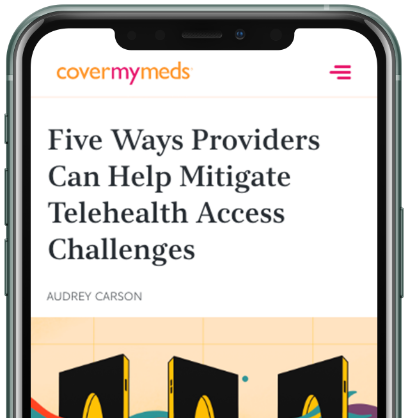Fax, Phone and ePA: Why Do Care Teams Balance All Three?
Despite the availability of electronic prior authorization (ePA) solutions to complete prior authorization requests, many healthcare providers still opt for manual phone and fax methods. Here we explore why care teams often balance all three methods of obtaining medication approval — despite the benefits of ePA solutions.

The start of a new year arrives with many promises. For healthcare providers, one they can count on is an influx of prior authorization (PA) requests and renewals. That’s in part due to insurance plan changes and existing PA expirations — both of which occur when the calendar flips.
Insurance plans require PA for medications for a variety of reasons, including when the medication:
- Has less expensive, equally effective alternatives
- Has dangerous side effects
- Is harmful when combined with other drugs
- Should only be used for certain health conditions
- Is often misused or abusedWhy do I need prior authorization for a prescription drug?, Blue Cross Blue Shield of Michigan
Regardless of when or why a PA is required, they can be taxing on providers and their staff. In 2021, 88% of providers surveyed ranked the burden associated with the PA process as “high” or “extremely high.” Additionally, 93% reported care delays associated with PA.2021 AMA prior authorization (PA) physician survey, American Medical Association
A deeper look into the survey results shows why. On average, healthcare practices complete 41 PA requests per physician, per week. Processing those requests takes approximately 13 hours — almost two business days.2021 AMA prior authorization (PA) physician survey, American Medical Association With physician burnout higher in 2022 than 2021,Physician Burnout & Depression Report 2022: Stress, Anxiety, and Anger, Medscape, Jan. 21, 2022 more administrative work is the last thing on a care team’s ideal to-do list.
Other trends suggest the volume of PA requests may keep growing. Within the next year, specialty medications — which often require PA approval — will account for 65% of products launched by biopharma companies.The Global Use of Medicine in 2019 and Outlook to 2023, IQVIA, Jan. 29, 2019 Currently, 84% of providers experience some level of difficulty starting patients on specialty medications and 51% say they spend 1-2 hours per patient on paperwork when initiating a complex therapy.2022 Medication Access Report, CoverMyMeds
As the prevalence of specialty medications increases, it’s likely the volume of administrative work providers must complete will follow suit. By finding a better way to complete PA requests now, providers can free up valuable time to spend directly with patients providing clinical care.
__To learn more about the current state of healthcare, download the 2022 Medication Access Report. __
By keeping physicians within their usual EHR workflow and reducing data entry, ePA provides an efficient alternative to traditional fax and phone methods.
American Medical Association
Advancing the PA process
PA is a cumbersome process that requires back-and-forth communication between prescribers, pharmacists, plans and PBMs — often at the expense of the patient. In 2020, 1 in 4 patients surveyed reported a delay in receiving their medication due to PA, and 1 in 10 experienced delays in receiving medications due to delays at their provider’s office.2021 Medication Access Report, CoverMyMeds
Industry experts — including the American Medical Association (AMA) — believe the overall volume of medications that require PA should be greatly reduced. And if a PA is necessary, they say it should use a standardized, automated process to help minimize administrative burden.Prior authorization practice resources, American Medical Association
Historically, phone and fax have been how PA requests get pushed through the process, but neither method is standardized nor automated. Thankfully, an alternative solution exists — electronic prior authorization (ePA).
And according to AMA, it’s an excellent option: “By keeping physicians within their usual EHR workflow and reducing data entry, ePA provides an efficient alternative to current fax and mail processes.”Simplifying Prior Authorization (video), Prior authorization practice resources, American Medical Association
But alternative solutions are only good if they get used. In 2020, just 33% of surveyed providers said they rely solely on ePA to submit PA requests.2021 Medication Access Report, CoverMyMeds If ePA exists — and is recommended by industry experts — why do 28% and 26% of providers still use phone and fax respectively?2022 Medication Access Report, CoverMyMeds
Let's dive in.
Why do providers still use phone and fax for PA?
As an industry, healthcare is slow to change and often paces behind from a technology perspective. The COVID-19 pandemic sped up the adoption of telehealth — in 2021, over 90% of providers offered a telehealth option for their patients.2021 Medication Access Report, CoverMyMeds However, many providers haven’t embraced other electronic advancements.
One theory why phone and fax are still ubiquitous is because HIPAA, the Health Insurance Portability and Accountability Act, specifically refers to phone and fax as acceptable ways of sharing protected health information (PHI) for treatment purposes.
However, it’s important to note that HIPAA was developed 26 years ago — before today’s HIPAA-compliant ePA solutions were invented.
Another theory is that, in general, providers don’t fully trust the formulary information in their EHRs. In a survey, 60% reported they only sometimes trust the insurance data available in their EHR, while 19% reported they rarely or never trust this information.2020 Electronic Prior Authorization Report, CoverMyMeds Since ePA is integrated into the EHR workflow, it’s possible that distrust may carry over. Real-time benefit check (RTBC) technology that provides accurate information at the point of prescribing can help.
There’s a common misconception that a provider’s decision to use phone, fax or ePA is an intentional choice — rather, it’s usually a reactive decision.
Anna Klattdirector of user experience at CoverMyMeds
For providers pressed on time, convenience is key
According to Anna Klatt, director of user experience at CoverMyMeds, there’s a common misconception that a provider’s decision to use phone, fax or ePA is an intentional choice. Rather, she said, it’s usually a reactive decision.
“Providers are extremely busy professionals,” Anna said. “They have too much to do and not enough time to do it, and they react to PA requests in real-time. If they receive a PA request via phone or fax, they’re likely to respond via that method. Likewise, if they get a notification that says, ‘Please complete an ePA for your patient,’ they’ll act accordingly.”
If there’s a sense of urgency, a provider may even perceive the phone as “faster” than ePA. That’s because they can have a human-to-human conversation, even if they’re on hold for an hour beforehand. To that point, if a provider wants to tell the story of why their patient needs a specific medication, they might feel they can better explain their rationale over the phone.
Despite those perceptions, a case study illustrated that patients access their medications an average of 13.2 days sooner when PA requests are submitted prospectively, at the point of prescribing, versus retrospectively, after the pharmacy says one is needed.2020 Electronic Prior Authorization Report, CoverMyMeds
Additionally, many ePA solutions allow providers to attach supporting comments and clinical documentation to ePA requests. Unfortunately, there’s a lack of awareness surrounding those features — that’s why improved care team training is critical.
Adoption is good but usage is better
More than two-thirds of providers have switched to an alternative medication after encountering a medication access barrier like PA during the prescribing process.2020 Medication Access Report, CoverMyMeds However, adoption isn’t necessarily the issue — after all, 96% of providers have adopted an ePA solution.2021 Medication Access Report, CoverMyMeds
Rather, usage is key. Because why have an ePA solution if you don’t use it?
To improve usage of ePA and move away from phone and fax, it’s important to get the entire care team on board — that includes prescribers, nurses, medical assistants, pharmacists and payers. That way, care teams will be prompted to submit PA requests within workflow, instead of responding to questions and requests from the patient’s pharmacy or plan later.
By completing PAs electronically instead of by phone or fax, providers can get back to why they went into healthcare to begin with — to help people.
The end goal is always improved patient care
In a survey, 82% of providers listed PA as a time-consuming part of their workday, and a third reported having less time for face-to-face interaction with patients due to PA management.2021 Medication Access Report, CoverMyMeds By completing PAs electronically instead of by phone or fax, providers can get back to why they went into healthcare to begin with — to help people.
While it’s possible that phone and fax will always have a place in the PA workflow — as a backup in case of a system failure, for example — they should rarely be the go-to. It’s important for care teams to know they can do everything via ePA that they can do via phone and fax — including for government-sponsored plans like Medicare and Medicaid. And it’s equally important that they can properly advocate for their patients in the process.
To learn more about how providers juggle PA requests, download the 2022 Medication Access Report.
The latest healthcare insights, floated right to your inbox.





